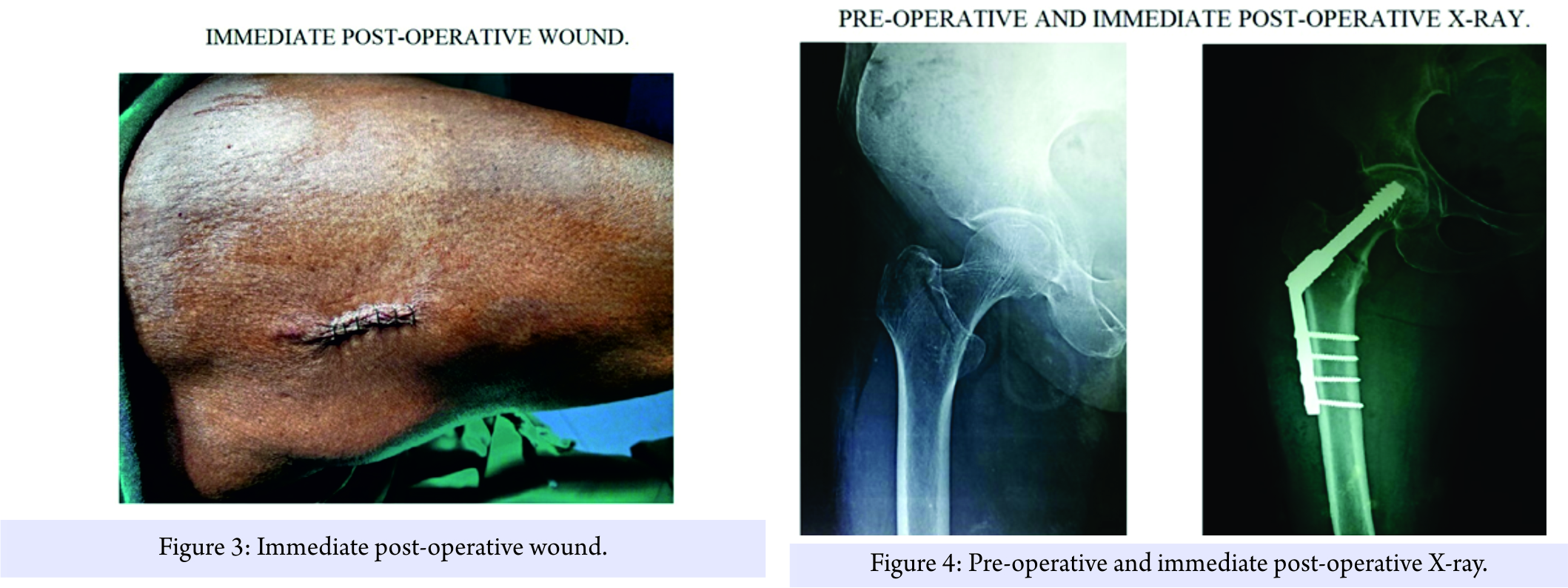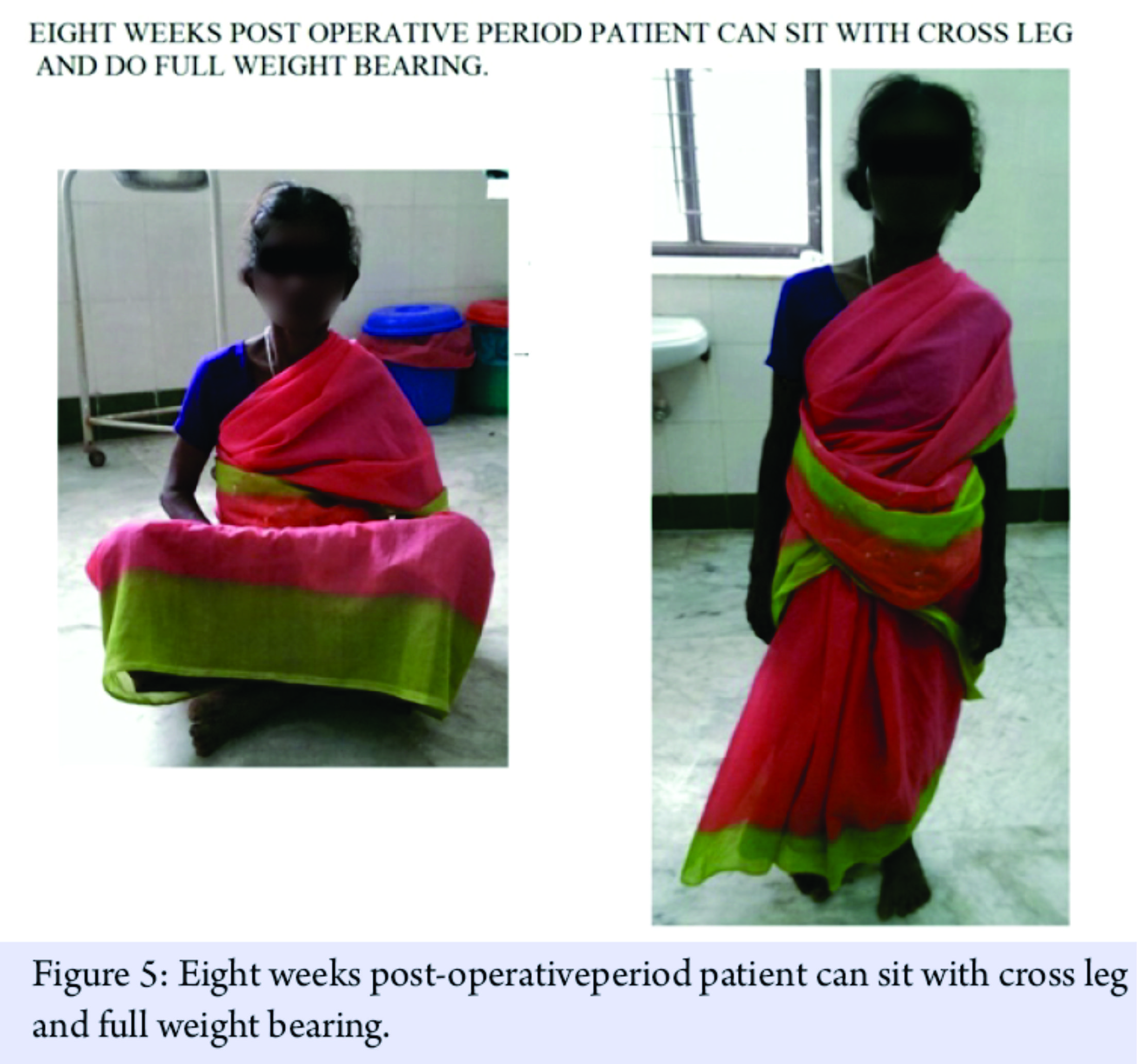[box type=”bio”] Learning Points for this Article: [/box]
How to manage a stable inter-trochanteric fracture with constrained operating time and blood loss. Use of new angle guide system with which minimal invasive DHS performed.
Case Report | Volume 7 | Issue 5 | JOCR Sep – Oct 2017 | Page 34-37| Ponnusami Pillai Gokulakrishnan, Anil Gowtham Manivannan, Sakthivel Annamalai, Balaji Umamaheshwaran. DOI: 10.13107/jocr.2250-0685.886
Authors: Ponnusami Pillai Gokulakrishnan [1], Anil Gowtham Manivannan [1], Sakthivel Annamalai [1], Balaji Umamaheshwaran [1]
[1] Department of Orthopaedics, K.G Hospital and Post Graduate Medical Institute, Coimbatore, Tamil Nadu, India.
Address of Correspondence:
Dr. Gokulakrishnan Ponnusami,
Department of Orthopaedics, K.G Hospital and Post Graduate Medical Institute, Coimbatore – 641018, Tamil Nadu, India.
E-mail: pgokulakrishnan24@gmail.com
Abstract
Introduction: Intertrochanteric fracture comprises nearly half of hip fractures occurring in elderly individuals with osteoporosis. Considering the age group of its population, they are often associated with multiple comorbidities which warrant optimum management with less surgical stress.
Case Report: This article reports the case of 56-year-old women with in tertrochanteric fracture associated with the cardiac complication restricting operating duration. Minimal invasive dynamic hip screw (MIDHS) fixation technique with modified instruments was performed which facilitated minimizing the operating time and intraoperative blood loss.
Conclusion: MIDHS fixation is an important technique for providing the necessary fixation minimizing soft tissue dissection, operating time, intra-operative blood loss and surgical expense without compromising fixation stability, and rehabilitation protocol.
Keywords: Intertrochanteric fracture, comorbid conditions, minimally invasive dynamic hip screw fixation, less surgical stress, cost-effective.
Introduction
Dynamic hip screw(DHS)fixation has proved successful in treating intertrochanteric fracture. However, DHS fixation method fails to achieve less soft tissue handling [1]. The next option is to select an intramedullary device to achieve less soft tissue handling. The intramedullary device even much stable on comparison with DHS, cost of the quality implant may go up to 4-fold high. To overcome this problem, minimal invasive DHS (MIDHS) technique will be a viable alternative [2]. In this article, we report a unique case of the patient with an intertrochanteric fracture who also has cardiac complication restricting the operative time and multiple blood transfusions. MIDHS were performed in this patient with short operating time and negligible operative blood loss.
Case Report
A 56-year-old women (weight 62kg; body mass index 24) sustained intertrochanteric fracture right side by self-fall. The patient status post-operative case of coronary artery bypasses surgery with an ejection fraction of 42%. On pre-operative evaluation, her hemoglobin level found to have very low (8.1mg/dl) with ASA Grade II. After obtaining cardiac and anesthetist evaluation patient was decided to treat surgically. Her cardiac problems restricted the surgeon on operative time and transfusions. 

Discussion
Open reduction and internal fixation have become a standard of care for intertrochanteric fracture fixation. On doing so, the surgeon has trouble in selecting the suitable implant for stable intertrochanteric fracture. Most of the surgeons prefer intramedullary device in view of reducing the operative time, and tissue damage as conventional DHS (CDHS) requires a greater amount of soft tissue handling than intramedullary device [3]. But Peyser et al., statsintramedullary procedures involve considerable tissue trauma (reaming and violation of the medullary canal) and relatively high bleeding and transfusion rates [4]. Hence, these implant cannot be considered true minimally invasive. As because of the short learning curve, low in complication rate and cost DHS considered to be effective in treating the stable intertrochanteric fracture[5]. Even both MIDHS and CDHS fixation technique yield reliable results, MIDHS fixation technique is superior in operating time, blood loss, post-operative pain, and length of hospital stay [6]. Yian et al. in his study describe the use of 3-hole side plate is as good as 4 holes in sharing tensile force [7]. A biomechanical study by McLoughlin et al. demonstrated that the 2-hole DHS is as stable as the 4-hole DHS in cyclic and failure loads [8]. Although recent studies suggest the use of 2 holes in view of achieving minimal incision length, the length of the side plate used in this case is 4 hole with purchase totally of 8 cortices which found to be safer on osteoporotic bone [2]. Another major pre-operative complication encountered in MIDHS is the injury to the perforator vessel. If so, it’s so difficult in achieve hemostasis through such a small wound. To avoid such situation, no sharp instruments used proximal to incision site, and moreover an angiographic study revealed that the transverse branch of the lateral circumflex artery was at sufficient distance from the surgical site, which allows surgeons to safely perform mini-incisions during surgery without fear of uncontrolled bleeding [9]. Apart from specially designed 135° angle guide used to minimize the initial surgical dissection fixation achieved by the routine instrument used for DHS fixation with which the operating team is familiar and confident, with no need to purchase new instruments.
Conclusion
As none of the literature reports much about angle guide used in MIDHS we presume this is the first case report using specially designed 2mm × 135° sleeve for angle guide (Fig. 2). This considerably reduces the proximal surgical dissection and maintain safe surgical zone while fixation. This case report demonstrates that MIDHS technique even not superior but will be a viable alternative in an elderly patient with comorbidity requiring minimal operative time. MIDHS technique helps orthopedic surgeon and hospital facing the challenge in providing health-care advantageous to patients with hip trauma in most cost-effective way.
Clinical Message
Proximal femoral surgeries always have a potential complication of profuse perforator bleeding if proper meticulous dissection not carried out, and henceforth increasing the operating time. To address situations demands including restricted operative time, minimal blood loss MIDHS will be a viable alternative. Specialized instrument sets which carry higher cost are not always required to execute successful MIDHS. Adding few specialized instruments to routine armamentarium facilitates us to perform MIDHS in cost-effective way. Limitationof this technique is obese patient, expertise in image intensifier utilization and steep learning curve.
References
1. Mahmood A, Kalra M, Patralekh MK. Comparison between conventional and minimally invasive dynamic hip screws for fixation of intertrochanteric fractures of the
femur. ISRN Orthop 2013;2013:484289.
2. DayanandM, Deepak S, Kumar M, Kumar V, Patil M. Management of intertrochanteric fractures of femurby minimally invasive dynamic hip screw. IOSR J Dent MedSci
2014;13:68-72.
3. Boldin C, Seibert FJ, FankhauserF, Peicha G, Grechenig W, Szyszkowitz R. The proximal femoral nail (PFN)- Aminimal invasive treatment of unstable proximal
femoral fractures: A prospective study of 55 patients with a follow-up of 15 months. ActaOrthopScand 2003;74:53-8.
4. Peyser A, Weil Y, Brocke L, Manor O, Mosheiff R, Liebergall M. Percutaneous compression plating versus compression hip screw fixation for the treatment of
intertrochanteric hip fractures. Injury 2005;36:1343-9.
5. Cheng T, Zhang G, Zhang X. Review: Minimally invasive versus conventional dynamic hip screw fixation in elderly patients with intertrochanteric fractures: A
systematic review and meta-analysis. SurgInnov 2011;18:99-105.
6. Wong TC, Chiu Y, Tsang WL, Leung WY, Yeung SH. A double-blind, prospective, randomised, controlled clinical trial of minimally invasive dynamic hip screw
fixation of intertrochanteric fractures. Injury 2009;40:422-7.
7. Yian EH, Banerji I, Matthews LS. Optimal side plate fixation for unstable intertrochanteric hip fractures. J Orthop Trauma 1997;11:254-9.
8. McLoughlin SW, Wheeler DL, Rider J, Bolhofner B. Biomechanical evaluation of the dynamic hip screw with two-and four-hole side plates. J Orthop Trauma
2000;14:318-23.
9. Alobaid A, Harvey EJ, Elder GM, Lander P, Guy P, Reindl R. Minimally invasive dynamic hip screw: Prospective randomized trial of two techniques of insertion of
a standard dynamic fixation device. J Orthop Trauma 2004;18:207-12.
 |
 |
 |
 |
| Dr. Ponnusami Pillai Gokulakrishnan. |
Dr. Anil Gowtham Manivannan |
Dr. Sakthivel Annamalai |
Dr. Balaji Umamaheshwaran |
| How to Cite This Article: Gokulakrishnan PP, Manivannan AG, Annamalai S, Umamaheshwaran B. Minimal Invasive Dynamic Hip Screw Fixation Technique in Patient with Cardiac Complications: A Case Scenario. Journal of Orthopaedic Case Reports 2017 Sep-Oct;7(5):34-37 |
[Full Text HTML] [Full Text PDF] [XML]
[rate_this_page]
Dear Reader, We are very excited about New Features in JOCR. Please do let us know what you think by Clicking on the Sliding “Feedback Form” button on the <<< left of the page or sending a mail to us at editor.jocr@gmail.com





